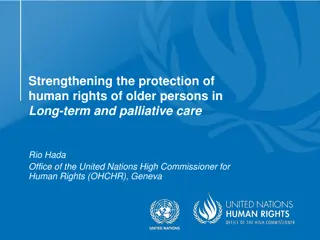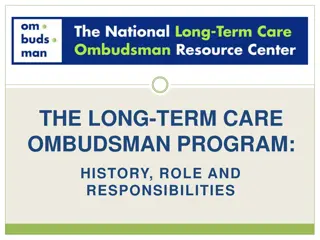Managing Combative Residents in Long-Term Care
Residents in long-term care facilities may exhibit combative behaviors due to underlying psychiatric conditions, cognitive impairment, or dementia. This aggression poses challenges for both staff and other residents. Caregiver training is crucial for identifying triggers and managing combative episodes effectively. Resident-to-Resident Aggression (RRA) is another concern, with factors like communication barriers and territorial issues leading to conflicts. Prevention strategies such as comprehensive resident assessments and observation can help mitigate RRA risks.
Download Presentation

Please find below an Image/Link to download the presentation.
The content on the website is provided AS IS for your information and personal use only. It may not be sold, licensed, or shared on other websites without obtaining consent from the author.If you encounter any issues during the download, it is possible that the publisher has removed the file from their server.
You are allowed to download the files provided on this website for personal or commercial use, subject to the condition that they are used lawfully. All files are the property of their respective owners.
The content on the website is provided AS IS for your information and personal use only. It may not be sold, licensed, or shared on other websites without obtaining consent from the author.
E N D
Presentation Transcript
Managing Combative Residents In Long Term Care Burt Dirkse, ARM, RCFE-A Director, Risk Services BDirkse@MWIAInsurance.com
Resident psychological trauma to both staff and other residents. 88,000 of the 1.3 million nursing home residents (6.8%) are physically aggressive each week.* Residents may have underlying psychiatric conditions, cognitive impairment and dementia, which contribute to combativeness. *Potentially Modifiable Resident Characteristics That Are Associated With Physical or Verbal Aggression Among Nursing Home Residents With Dementia, 2006 aggression causes physical and
Caregiver training can provide the knowledge to identify certain behaviors that can prevent an actual combative episode. The outburst is not a personal attack on the caregiver; it is the resident s way of communicating a need, want or desire.
Resident-to-Resident Aggression Resident-to-Resident aggression (RRA) most frequently happens in dining room and resident rooms. RRA triggers: Communication/language barriers Entering the room of another resident Territoriality (sharing common items) Inability to communicate needs effectively Room temp, TV volume, window shade, lighting
RRA, continued Other factors that contribute to RRA: Roomate conflict Responses to loud noises Jealousy Racial, ethnic and religious affiliation can trigger RRA Psychological impairment=communication and negotiation skills are diminished, leading to conflict (verbal and physical)
RRA Prevention: Perform a careful and comprehensive resident assessment before admission to identify individual triggers (physician report, care plan, chart, family interview, etc) Observe resident in their current situation Consider their background, acuity level (psych and physical), cultural norms and biases when placing them with roomates. Observe initial placement and comments/complaints.
Combativeness with Caregivers Contributing factors Activities: dressing, bathing, turning, transferring can be confusing to residents, who may lash out. Residents who can t verbalize needs such as hunger, pain, thirst, toileting, body temp and sleep disruption may use combative gestures. Environmental factors: light, noises, voices, traffic in room, roommate activity Resident health: their health status and psych condition may impact their combativeness, and their perception of reality may be altered.
Strategies to Reduce Combativeness Evaluate resident and the situation: What are they trying to communicate ? Are they confused trying to perform ADLs ? What was happening prior to the episode ? Are they oriented to the past and have trouble accepting present ? Any loud noises ? Are physical needs met (hunger, pain, thirst, toileting, temp, sleep disruption) Any new meds (side effects) Any new routines, triggers or external factors ? 1 2 3 4
Strategies to Reduce Combativeness Ask family about past behaviors or life experiences that may contribute to episiodes Identify what causes problem behaviors (activity, condition or situation).
Activity: Bathing: Consider patient past experience (shower vs. bath vs sponge bath) Modesty factors (cultural, ethnic, religious, gender pref.) Timing (time of day, when is resident most cooperative/least stressed ?) Temp of room and water. Any pain with movement ? (pain meds prior to bath) Explain the bathing process to each resident each time, including while undressing them. Don t just pull them from their room, undress them and start touching them
Activity: Mealtimes: seating preference ? Dining companions ? Wandering: Redirect pacing into productive activity Reassue resident if they appear disoriented Sleep Problem Mgt: Address nightime restlessness with Improved sleep hygiene (incontinent ?) Reduce noise and light, play soothing music Keep consistent sleep schedule Use night lights Provide favorite stuffed animal or blanket Increase activity during the day, monitor napping Limit caffeine
Activity: Toileting Is resident incontinent ? Keep toileting schedule Manage incontinence with pre-bed toileting, even if resident says they don t have to go (they often will when on toilet). Avoid constipation (inactivity and some meds contribute to constipation, which can cause pain and anger.
Condition: Confusion & Agitation Illness, UTI, pneumonia ? Prior drug/alc history ? Med changes or interactions ? Side effects ? Stroke/ CV accident ? May result in personality changes Psychological problems ? History of depression, mental illness ? Are these being treated ?? Side effects of psychotropic meds. Pain: is res able to articulate pain ? Combative outbursts may be the result. Changes in functional status ? Hearing loss: able to understand commands vs. just nodding Visual acuity: is vision declining ? This can result in frustration and fear
Situation Environmental Adjustments: Modify the env t to reduce agitation Extrinsic factors: minimize loud, distracting noises. Relocate resident is necessary Flooring: minimize floor glare, choose flooring patterns/colors that are calming Room temp: hot and cold affect resident comfort Room placement: Is resident compatible with roommate ? Is resident territorial (chair, bed, clothes, TV) ?
Situation Prevention & De-escalation Maintain your composure (be aware of your emotions, tone, body language) Approach resident calmly and express support, use positive/friendly facial expressions. Always approach resident from the front, not the back. Active Listening: engage resident to determine needs, if possible Effective verbal responding: reflect/paraphrase to clarify understanding. Use gentle, relaxed tone. Redirection: provide options of other activities or places. Stance: talk with them at eye level. Arms at sides, not crossed. Maintain appropriate distance if potential for hitting exists. Do NOT initiate physical contact if the resident s behavior is escalating. Touching can trigger violence in some. Positioning: is res comfortable ? Repositioned regularly as needed ? Jumping to conclusions: input from other team members is helpful, however, fully assess the resident/situation/environment. Never assume. Resident stress management: exercise, walking, calming music, pet therapy, favorite doll or blanket.
Situation Implement Resident Care Plan for interventions and communicate patient needs to staff to minimize behaviors. Work with entire care team Make goals realistic: you may not be able to stop all behavioral problems, but can reduce them. Evaluate staff responses to the episode/outburst. Consider manner of approach of resident, movement near resident, be at resident eye level, listen to resident, accept/acknowledge resident feelings, don t correct them or argue with them, use calm tone of voice. Implement education & training based on findings from episode. Look for themes, trends by resident.
Summary Any questions ? Specific situations or challenges in your facility ? Any lessons learned on addressing combativeness ? Discussion of specific residents or outbursts ? Solutions ? Combativeness in long term care may always be present, but we can reduce resident combativeness with staff education and training necessary to identify triggers which increase combativeness.























